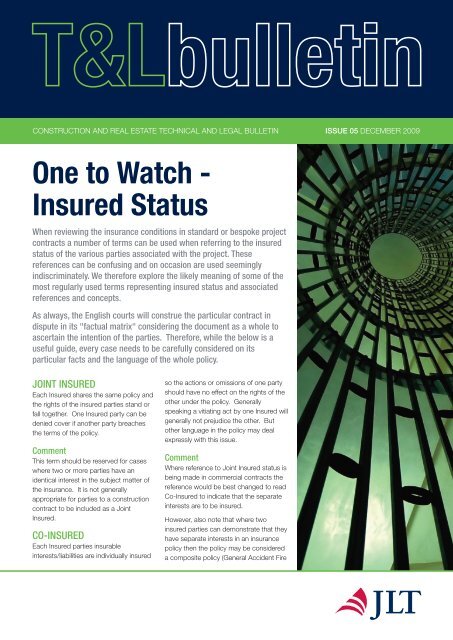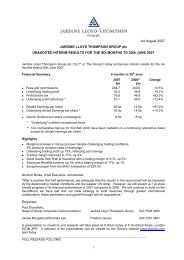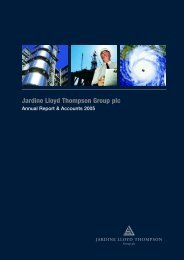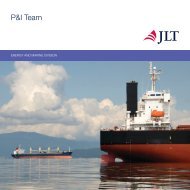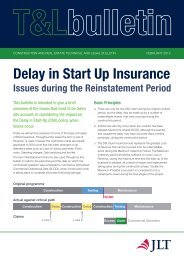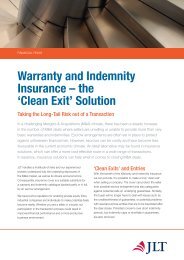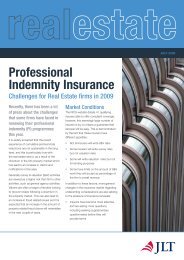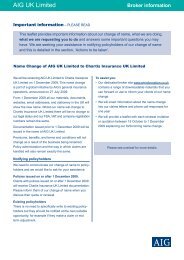One to Watch - Insured Status - JLT
One to Watch - Insured Status - JLT
One to Watch - Insured Status - JLT
Create successful ePaper yourself
Turn your PDF publications into a flip-book with our unique Google optimized e-Paper software.
T&Lbulletin<br />
CONSTRUCTION AND REAL ESTATE TECHNICAL AND LEGAL BULLETIN ISSUE 05 DECEMBER 2009<br />
<strong>One</strong> <strong>to</strong> <strong>Watch</strong> -<br />
<strong>Insured</strong> <strong>Status</strong><br />
When reviewing the insurance conditions in standard or bespoke project<br />
contracts a number of terms can be used when referring <strong>to</strong> the insured<br />
status of the various parties associated with the project. These<br />
references can be confusing and on occasion are used seemingly<br />
indiscriminately. We therefore explore the likely meaning of some of the<br />
most regularly used terms representing insured status and associated<br />
references and concepts.<br />
As always, the English courts will construe the particular contract in<br />
dispute in its "factual matrix" considering the document as a whole <strong>to</strong><br />
ascertain the intention of the parties. Therefore, while the below is a<br />
useful guide, every case needs <strong>to</strong> be carefully considered on its<br />
particular facts and the language of the whole policy.<br />
JOINT INSURED<br />
Each <strong>Insured</strong> shares the same policy and<br />
the rights of the insured parties stand or<br />
fall <strong>to</strong>gether. <strong>One</strong> <strong>Insured</strong> party can be<br />
denied cover if another party breaches<br />
the terms of the policy.<br />
Comment<br />
This term should be reserved for cases<br />
where two or more parties have an<br />
identical interest in the subject matter of<br />
the insurance. It is not generally<br />
appropriate for parties <strong>to</strong> a construction<br />
contract <strong>to</strong> be included as a Joint<br />
<strong>Insured</strong>.<br />
CO-INSURED<br />
Each <strong>Insured</strong> parties insurable<br />
interests/liabilities are individually insured<br />
so the actions or omissions of one party<br />
should have no effect on the rights of the<br />
other under the policy. Generally<br />
speaking a vitiating act by one <strong>Insured</strong> will<br />
generally not prejudice the other. But<br />
other language in the policy may deal<br />
expressly with this issue.<br />
Comment<br />
Where reference <strong>to</strong> Joint <strong>Insured</strong> status is<br />
being made in commercial contracts the<br />
reference would be best changed <strong>to</strong> read<br />
Co-<strong>Insured</strong> <strong>to</strong> indicate that the separate<br />
interests are <strong>to</strong> be insured.<br />
However, also note that where two<br />
insured parties can demonstrate that they<br />
have separate interests in an insurance<br />
policy then the policy may be considered<br />
a composite policy (General Accident Fire
and Life Assurance Corporation Ltd vs<br />
Midland Bank Ltd 1940) and therefore<br />
even where the expression Joint <strong>Insured</strong> is<br />
being used in commercial construction<br />
contracts such as ICE standard contract,<br />
or Joint Names as is used in JCT forms,<br />
any insurance placement should still be<br />
placed on a composite basis.<br />
NAMED INSURED / ADDITIONAL<br />
INSURED<br />
This terminology is more common place in<br />
the USA where policy construction can be<br />
a little different <strong>to</strong> European formats.<br />
A Named <strong>Insured</strong> should be defined in the<br />
policy (such as X plus associated<br />
/subsidiary companies etc) and will usually<br />
have the benefit of all coverage given<br />
under the policy. Where a Named <strong>Insured</strong><br />
wants <strong>to</strong> include another party under the<br />
policy (who doesn't fall within the definition<br />
of Named <strong>Insured</strong>) then the policy needs<br />
<strong>to</strong> be specifically endorsed <strong>to</strong> include that<br />
party as an Additional <strong>Insured</strong>. By<br />
comparison, composite policies in the UK<br />
tend <strong>to</strong> list all insured in the one insurance<br />
schedule. When this has been endorsed<br />
the Additional <strong>Insured</strong> will usually enjoy the<br />
same benefits under the policy as the<br />
original named insured although the<br />
endorsed Additional <strong>Insured</strong> status can be<br />
subject <strong>to</strong> coverage, terri<strong>to</strong>ry or time<br />
restrictions if expressly stated in the<br />
endorsement.<br />
Comment<br />
When a client is required by contract <strong>to</strong><br />
insure another commercial entity under<br />
their own insurances as an Additional<br />
<strong>Insured</strong>, or where a client is requiring<br />
another commercial entity by the terms of<br />
a contract <strong>to</strong> provide them with Additional<br />
<strong>Insured</strong> status, then it is worth checking<br />
that full insured status has been achieved<br />
as would be the case as a Co-<strong>Insured</strong>. In<br />
other words it is worth checking that the<br />
endorsement creating this Additional<br />
<strong>Insured</strong> status is complete. There should<br />
be no difference in the extent of cover<br />
provided <strong>to</strong> the additional insured<br />
compared with the named insured unless<br />
this was specifically agreed and therefore<br />
intended.<br />
NOTING OF INTEREST<br />
Having your interested noted on an<br />
insurance policy does not necessarily<br />
mean that you will be entitled <strong>to</strong> be<br />
compensated for a loss insured under the<br />
terms of the insurance contract.<br />
Comment<br />
In order <strong>to</strong> properly protect an insurable<br />
interest then the party with the interest<br />
should be included as an insured party<br />
under the insured contract.<br />
RESPECTIVE RIGHTS AND<br />
INTERESTS<br />
The number of insured parties identified as<br />
'the insured' under an insurance policy and<br />
the scope of cover afforded <strong>to</strong> those<br />
insured parties may be wider than required<br />
by the relevant construction contracts.<br />
The phrase 'for their respective rights and<br />
interests' is sometimes inserted after the<br />
names of the insured parties, and the<br />
effect of this may be <strong>to</strong> limit the application<br />
of the insurance <strong>to</strong> no more than required<br />
by the contract (s) between the parties. It<br />
also adds an additional indication that that<br />
policy is composite and that all insured<br />
parties are <strong>to</strong> therefore be treated<br />
separately.<br />
The case of National Oilwell (UK) Ltd v<br />
Davy Offshore Ltd (1993) showed that the<br />
courts are prepared <strong>to</strong> recognise the<br />
wording of construction contracts in<br />
deciding the extent of insurance available<br />
under insurance policies. In this case, a<br />
Construction All Risks insurance policy<br />
included National Oilwell as 'other<br />
Assureds' and specified that 'the interest<br />
of other Assureds shall be<br />
covered….unless specific contracts<br />
contain provisions <strong>to</strong> the contrary'. The<br />
contract between Davy and National<br />
Oilwell stated that Davy would insure the<br />
materials of National Oilwell until the time<br />
of delivery. A loss occurred after delivery<br />
and, because of the terms of the contract,<br />
insurers were allowed <strong>to</strong> deny coverage <strong>to</strong><br />
National Oilwell in this case.<br />
This should not however be confused with<br />
an <strong>Insured</strong>s "pervasive interest" which<br />
permits an insured party <strong>to</strong> be insured for<br />
more than their own interest in an insured<br />
asset. For example under a composite<br />
Construction "all risk" policy a<br />
subcontrac<strong>to</strong>r can be insured for their<br />
"pervasive interest" in the whole contract<br />
works, based on his potential liability for<br />
damage <strong>to</strong> those works, even though<br />
there is no proprietary or possessory right<br />
in such property.<br />
Comment<br />
In order <strong>to</strong> protect the interest of 'Other<br />
<strong>Insured</strong>s' the insurance provisions of the<br />
contract should be carefully reviewed <strong>to</strong><br />
make sure they accurately reflect the<br />
intention of the parties. If it is the intention<br />
of a Construction 'All Risks' policy <strong>to</strong><br />
provide full cover <strong>to</strong> the 'other insureds'<br />
then avoid clauses in the insuring<br />
provisions of the policy such as:<br />
'unless specific contract(s) contain<br />
provisions <strong>to</strong> the contrary, in which event<br />
insurance hereunder for such specific<br />
contract(s) only shall be limited<br />
accordingly…'<br />
WAIVER OF SUBROGATION<br />
Following the cases of Hopewell Project<br />
Management v Ewbank Preece (1998) and<br />
Co-operative Retail Services v Taylor<br />
Young Partnership (2002) it was generally<br />
accepted that an insurer cannot exercise a<br />
right of subrogation against a co-insured.<br />
The recent case of Tyco Fire & Integrated<br />
Solutions Ltd v Rolls-Royce Mo<strong>to</strong>r Cars<br />
Ltd (2008) has however thrown some<br />
doubt on this assumption. The judgment<br />
in this case held that the Tyco (the<br />
contrac<strong>to</strong>r) was liable <strong>to</strong> indemnity Rolls-<br />
Royce (the employer) for damage <strong>to</strong> Rolls-<br />
Royce's existing structures caused by<br />
Tyco's negligence, despite a contractual<br />
requirement for Rolls-Royce <strong>to</strong> maintain a<br />
joint names insurance for specified perils.<br />
The facts<br />
Rolls-Royce contracted Tyco <strong>to</strong> design<br />
and construct a sprinkler system at its<br />
assembly plant. During construction, and<br />
due <strong>to</strong> the negligence of Tyco, a large<br />
quantity of water escaped causing<br />
damage <strong>to</strong> both the works and existing
T&Lbulletin<br />
This newsletter is published for the benefit of clients and prospective<br />
clients of Jardine Lloyd Thompson Limited. It is intended only <strong>to</strong> highlight<br />
general issues relating <strong>to</strong> the subject matter which may be of interest and<br />
does not necessarily deal with every important <strong>to</strong>pic nor cover every aspect<br />
of the <strong>to</strong>pics with which it deals. If you intend <strong>to</strong> take any action or make<br />
any decision on the basis of the content of this newsletter, you should<br />
first seek specific professional advice and verify its content.<br />
© Jardine Lloyd Thompson Limited – December 2009. All rights reserved.<br />
structure. Tyco repaired the works, but<br />
Rolls-Royce sought <strong>to</strong> recover losses<br />
flowing from damage <strong>to</strong> the existing<br />
structure. Rolls-Royce relied upon a term in<br />
the contract by which Tyco indemnified it<br />
against damage arising from Tyco's<br />
negligence. Tyco contended that it was<br />
relieved of this liability because the parties<br />
had agreed under contract <strong>to</strong> allocate such<br />
risk under a clause requiring Rolls-Royce <strong>to</strong><br />
maintain, in the joint names of the Employer<br />
and the Contrac<strong>to</strong>r, insurance of the works<br />
and the existing structure.<br />
The Decision<br />
The Court of Appeal held that Tyco<br />
remained liable for damage <strong>to</strong> the existing<br />
structures caused by their negligence. The<br />
court said obiter (so not formally part of the<br />
judgment), that there is no overriding rule of<br />
law that co-insured's (under a construction<br />
contract) cannot sue one another (or an<br />
insurer sue by way of subrogation) in<br />
respect of damage within the scope of a<br />
joint names policy - the position must be<br />
determined on a true construction of the<br />
contract.<br />
Comment<br />
Where there is no cross reference between<br />
the insurance and indemnity clauses of a<br />
contract there may be nothing in the<br />
doctrine of subrogation <strong>to</strong> prevent an insurer<br />
from suing a co-insured in the absence of<br />
an express waiver of subrogation. Please<br />
refer <strong>to</strong> the details of the Tyco case which<br />
have been widely reported and commented.<br />
This is a difficult area of law that will no<br />
doubt become clearer as it is further tested<br />
in the courts but the case serves as a<br />
reminder that where a contract provides for<br />
joint names insurance, consideration should<br />
given <strong>to</strong> the need for contractual provisions<br />
dealing with a waiver of subrogation.<br />
NON-VITIATION<br />
From the above examination a non-vitiation<br />
clause (which expressly distinguishes the<br />
rights of each insured party and expressly<br />
states that the insurer will only implement<br />
any rights that they may have against the<br />
vitiating insured) may be considered<br />
unnecessary where the interests of the<br />
insured parties are insured via a composite<br />
policy. However, it is possible that all such<br />
rights could be collectively affected, for<br />
example the broker acting on behalf of all<br />
insured could fail <strong>to</strong> inform the insurer of a<br />
fact material <strong>to</strong> them all; alternatively the<br />
insured may collectively have ongoing<br />
obligations via a policy warranty for proper<br />
maintenance of the property in question.<br />
Non-vitiation provisions are therefore used<br />
<strong>to</strong> deal with circumstances that could<br />
otherwise effect all insured parties,<br />
irrespective of composite policy status.<br />
Such provisions may also include a noninvalidation<br />
clause in the insurance <strong>to</strong> the<br />
effect that an individual insureds interest<br />
should not be prejudiced by any act or<br />
neglect of the insured in respect of any<br />
property insured, provided the insured, on<br />
becoming aware, immediately gives written<br />
notice <strong>to</strong> the insurers and pays an additional<br />
premium if required.<br />
Comment<br />
Lenders on limit recourse financing<br />
transaction generally require a non-vitiation<br />
clause as part of their specifically required<br />
Lender Endorsements. Non-vitiation<br />
conditions are also generally used on project<br />
construction policies perhaps using a variant<br />
on the LEG Multiple <strong>Insured</strong> Clause. The use<br />
of such clauses can also introduce the<br />
concept of innocent non-disclosure not<br />
being deemed a vitiating act by an insured<br />
and therefore offers a benefit <strong>to</strong> all insured<br />
parties. Such conditions will generally have<br />
a cost implication.<br />
Jardine Lloyd Thompson Limited<br />
6 Crutched Friars London EC3N 2PH<br />
Tel +44 (0)20 7528 4000<br />
Fax +44 (0)20 7528 4500<br />
Lloyd's Broker. Authorised and Regulated by the Financial Services<br />
Authority. A member of the Jardine Lloyd Thompson Group. Registered Office:<br />
6 Crutched Friars, London EC3N 2PH. Registered in England No. 01536540.<br />
VAT No. 244 2321 96. www.jltgroup.com. © December 2009


